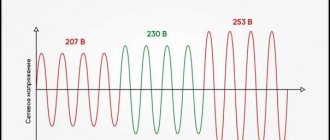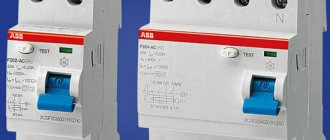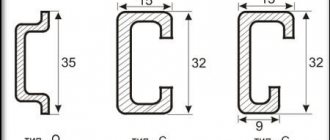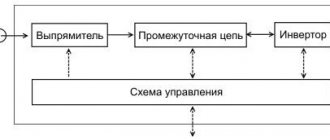Network overvoltage concept
Different sources provide different definitions of “overvoltage” in a network. Here is the definition of this concept given by Wikipedia:
The Nautical Dictionary defines overvoltage as an increase in voltage in power lines and electrical networks to such a level that it may damage the insulation.
According to GOST R 54130-2010, overvoltage is the excess of the highest operating voltage, which is set for a given type of electrical equipment.
The Russian Encyclopedia of Occupational Safety defines overvoltage as a significant voltage of a conductor relative to the ground, which can significantly exceed the phase voltage as a result of internal or atmospheric phenomena
Characteristics of overvoltage in the electrical network
In general, overvoltage can be considered any significant increase in voltage in the network caused by various reasons. Voltage drops can have different amplitudes, durations and frequency.
The main characteristics of overvoltage include:
- peak voltage value
- overvoltage repetition rate
- time of the rise period of the overvoltage value
- area or length of overvoltage propagation in the network
- total number of surges over a period of time
- total time of the entire overvoltage cycle
Classification by location of overvoltage occurrence
- internal – arising due to accidents, switching and various resonance phenomena;
- external – the source is a lightning discharge or any other external source.
In addition, internal overvoltages are classified into:
- atmospheric (formed as a result of lightning discharges);
- switching (arising as a result of switching);
- transient, caused by industrial frequency currents;
- electrostatic (arising as a result of electrostatic influences).
Let's look at each variety separately.
- Atmospheric overvoltages are considered the most dangerous type of emergency processes. They are natural phenomena and are caused by lightning discharges during precipitation when electrical charges are concentrated on the surface of objects.
This type of atmospheric phenomena is characterized by a high voltage rating, which can reach several tens of thousands of volts over a period of time up to 1 ms.
Not only electrical wiring, but also various types of equipment cannot withstand such powerful energy flows.
- Switching overvoltages are formed as a result of a sharp change in the operating mode of the electrical network, associated with changes in the on/off of powerful receivers, with the capacitive or inductive nature of the load. Such phenomena in electrical networks are usually called transient processes. The value of pulses and waves in this case reaches tens - hundreds of volts and is determined by the characteristics of the electrical network.
Another video about surge protection:
Types of overvoltage in the electrical network
In general, according to the method of formation, internal (or switching) and external (lightning or atmospheric) overvoltages are distinguished
There are the following main types of overvoltage in the electrical network:
- lightning surges
- inductive overvoltages
- quasi-stationary overvoltages
- switching overvoltages
The causes of switching overvoltages are
- disabling/enabling relay protection devices (circuit breakers, fuses, relays, contactors);
- stopping or starting powerful synchronous, asynchronous motors, transformers;
- turning on/off static capacitor banks.
3. Electrostatic overvoltages occur mainly in dry environments when electrostatic discharge accumulates, which form an electrostatic field.
4. Transient overvoltages occur under the influence of industrial frequency voltages.
Such phenomena occur due to internal damage due to phase/case defects, breakage of the neutral conductor, etc. the frequency of such processes is equal to the network frequency.
Quasi-stationary overvoltage in the network
Quasi-stationary overvoltages in the network can last from several seconds to several minutes. Such overvoltages are dangerous for equipment connected to the network.
Quasi-stationary overvoltages occur for the following reasons:
- the appearance of dangerous resonance in the electrical network
- in case of short circuits in the network
- during an emergency increase in the speed of the electric generator in the event of a sharp drop in the load value in the network
- when the ferroresonance effect appears in networks with powerful inductive coils or magnetic cores
What is network overvoltage and what is its danger?
This term means an increase in voltage in electrical networks or power lines above the established norm. It is limited to 5.0% and 10.0% (permissible and maximum permissible deviation, respectively). GOST 13109 91, which describes the standards that the quality of electricity must comply with, gives a more detailed definition of this effect. The regulatory document describes two options for the manifestation of high voltage :
- Pulse overvoltage. It manifests itself as a sharp increase in voltage amplitude, after which a decrease to the original or close to it level is observed (see A in Fig. 1). Pulse duration is less than 10.0 milliseconds.
- The effect of temporary overvoltage. In this case, an excess of more than 10.0% of the nominal value is observed for longer than 10.0 ms (see B in Fig. 1).
Fig. 1. Example of pulse (A) and temporary (B) overvoltage
Overvoltages are dangerous because they can not only damage devices connected to the network, but also destroy the insulation of electrical equipment. In the latter case, a threat to human life is created and the risk of an emergency situation increases. Damage to the insulation of electrical installations quite often causes fires.
Fire caused by overvoltage
In this regard, when choosing insulation, you must be guided by the relevant standards; detailed information about this can be found on the pages of our website.
Network surge protection
The responsibility for protecting electrical networks from natural and man-made factors lies with the organizations servicing these networks. Equipment for lightning protection and protection against voltage surges in high-voltage networks is installed on transmission line supports and masts, and at electrical substations of all levels. Network protection equipment is also installed at substations of factories and factories, power substations for powering electric transport networks.
To protect the electrical equipment of the house and household electrical appliances in private houses and apartments, local devices can be installed to protect against voltage surges and surges.
manufactures a line of surge and surge protection devices. More information about these devices can be found in the “Power Surge Protection” section.
All voltage protection devices comply with the requirements of Russian and international standards.
Albatross surge and surge protection devices will reliably protect your network, electrical equipment and household appliances from the harmful effects of power surges and surges.
Main reasons
Since external factors of influence have already been considered, let’s immediately move on to the internal reasons that cause an increase in voltage, starting in order. Switching factors:
- Abrupt load shedding when protective devices are triggered, for example, air circuit breakers, creates strong interference, especially during an emergency shutdown of power lines.
- Switching of capacitor units.
- Turning off powerful electrical machines and power transformers (causes the impact of inductive currents on the line).
- Reswitching of lines.
An example of typical switching voltage deviation is marked in blue in the graph below.
Typical switching overvoltage
Quasi-stationary deviations can be caused by the following factors:
- Regime , these include:
- asymmetrical short circuit to earth in a network with an isolated neutral;
- arc faults in lines with voltage 6.0-35.0 kV (arc overvoltage);
- acceleration of the generating set due to sudden load shedding;
- incorrect phasing of transformer installations;
- other unfavorable combinations of EMF in the electrical network.
- Resonant overvoltages . They arise when the frequencies of the forced EMF and a separate section of the network are close to coincidence. If this happens, the "capacitive effect" will result in overvoltage.
In the case when the line operates in open-phase mode and a transformer with a grounded neutral is connected to it, there is a high probability of the formation of a resonant circuit. The interaction will occur between the inductance of the transformer installation and the interphase capacitance and will also cause a high overvoltage factor.
- Ferroresonance overvoltage . This type of deviation can be observed during the formation of a resonant oscillatory circuit that meets the following conditions:
- frequency is close to 50.0 Hz;
- lower and higher harmonics occur;
- the inductive component has a saturated magnetic circuit.
In the open-phase operating mode of the system, the effect of ferroresonance is possible in circuits where there is inductance formed by transformers connected in series.











